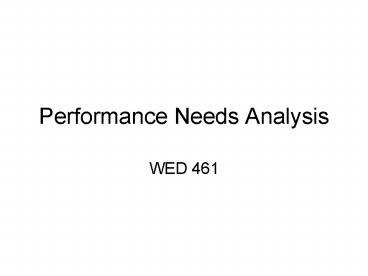Performance Needs Analysis - PowerPoint PPT Presentation
1 / 28
Title:
Performance Needs Analysis
Description:
... a performance analysis before any other type of needs assessment ... Oh, So Method. Oh Questions (if) Collect more information. Reflect understanding. ... – PowerPoint PPT presentation
Number of Views:24
Avg rating:3.0/5.0
Title: Performance Needs Analysis
1
Performance Needs Analysis
- WED 461
2
Conduct training needs assessments, including
performance, task, and goal analyses, feasibility
studies, wants versus needs surveys, and analysis
of target populations and the training context.
3
Performance Analysis
- Identify how to conduct a performance analysis.
- Use informal methods for performance analysis.
- Use formal methods for performance analysis.
- Discuss issues and concerns about performance.
4
PA Defined
- is also called gap or front-end analysis.
- has an implied or explicit standard for
performance. - identifies an important deficiency.
- has a root cause.
5
Purpose
- To identify the cause of deficient performance so
appropriate corrective action can occur. - To determine if the issue or problem is called by
a knowledge, skill, or attitude deficiency.
6
It is appropriate to conduct a performance
analysis before any other type of needs
assessment since the issue may not require a
training solution.Product Needs Assessment
Protocol
- Important
7
Needs Assessment Protocol
- Getting Started
- Performance Analysis
8
Performance Analysis Methods
- Front-End Analysis
- Oh, So
- Can-Cant/Will-Wont
- Root Cause Analysis
- Performance Barriers
- Post-Training Analysis
9
Oh, So Method
- Oh Questions (if)
- Collect more information.
- Reflect understanding.
- So Questions (then)
- Identify goals.
- Expand outcome details.
- Draw conclusions.
10
Can-Cant/Will-Wont Method
11
Root Cause Analysis
- Four Possible Causes
- Knowledge Deficit
- Skill Deficit
- Attitude Deficit
- Environmental Problem
12
Performance Barriers Method
- Personal Barriers
- Environment Barriers
- Information Barriers
- See Tool 2.2 (p. 24)
13
Personal Barriers
- Physical/capacity
- Emotional/motives
- Intellectual/skill and knowledge
- See Tool 2.3 (p. 25)
14
Environment Barriers
- Physical/resources
- Emotional/incentives
- Intellectual/procedures or methods
- See Tool 2.3 (p. 26)
15
Information Barriers
- Physical/task expectations
- Emotional/mission
- Intellectual/information flow
- See Tool 2.3 (p. 27)
16
Post Training Method
- When do you use this method?
- Questions are about
- Learner participation
- Meeting course objectives
- Skill performance during training
- On-the-job transfer
- Minimum performance standards
- Tool 2.4 (pages 28-29)
17
Case Studies
- Post-Training Case Study Is This a Sweet Deal?
- Post Training Case Study You Pick
18
Issues and Concerns
- Desire to train without analysis
- Limited access to gap people
- Anonymity of responses
- Money/costs
19
Remember Getting Started
- Agree with client (i.e., the decision maker) to
define the deficiency. - Identify the type of assessment information
needed. - Identify the degree of formality of the
assessment. - Identify who will be involved.
- Product Needs Assessment Protocol
20
1. Agree with client to define the deficiency.
- Ask the client the five purpose questions (why,
who, how, what, and when) an informal
assessment. - Present examples or testimonials from other
clients. - Draft a quick feasibility analysis.
21
2. Identify the type of assessment information
needed.
- Ask the client the analysis questions (See Tool
1.1 on Page 8). - Select the right type of needs analysis by
identifying the answers needed by the analysis.
22
3. Identify the degree of formality of the
assessment.
- Answer the five purpose questions (information
needs assessment). - If the client cannot answer the five purpose
questions, design a more formal needs assessment. - Identify the three-part process.
- Identify the benefit for each stakeholder.
23
Case Studies
- Case Study Is This a Sweet Deal?
- Case Study Workplace Issues
24
Key Points, You Decide
25
(No Transcript)
26
Case Study Is This a Sweet Deal?
- Text Pages 12-14 30-32
27
Case Study Customized Certificate Program
- The Challenge
- A government audit identified weaknesses among
the staff of a U.S. federal agency CFO. The
Presidents Management Agenda initiatives in
finance and budgeting and federal financial
systems made remediation of the problems
identified in the audit even more urgent.
28
(No Transcript)































